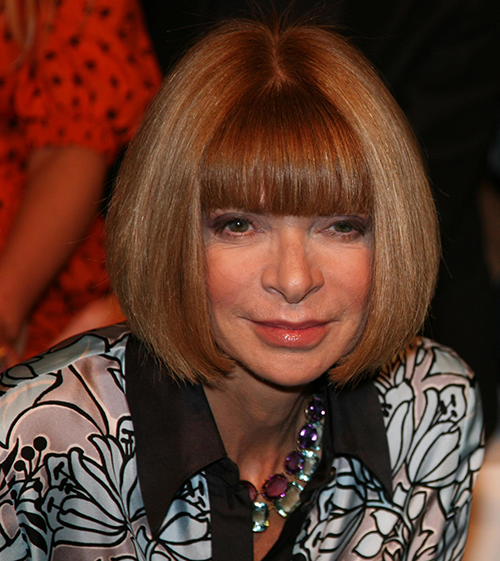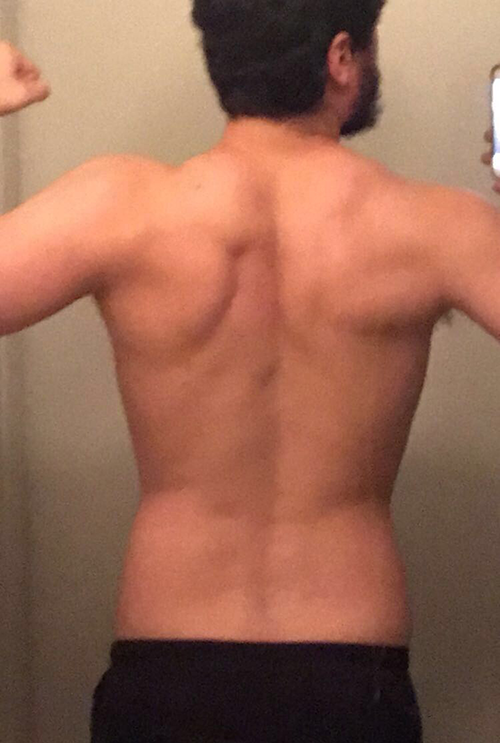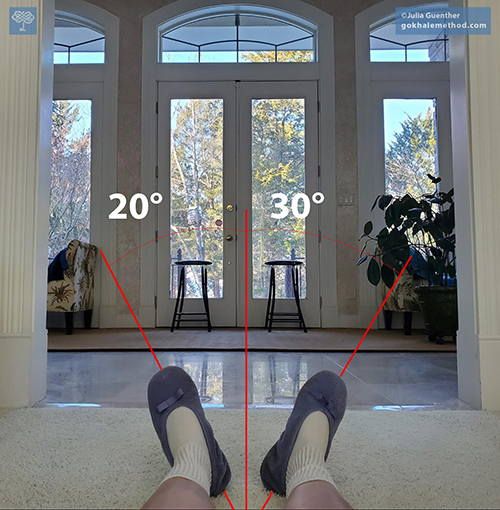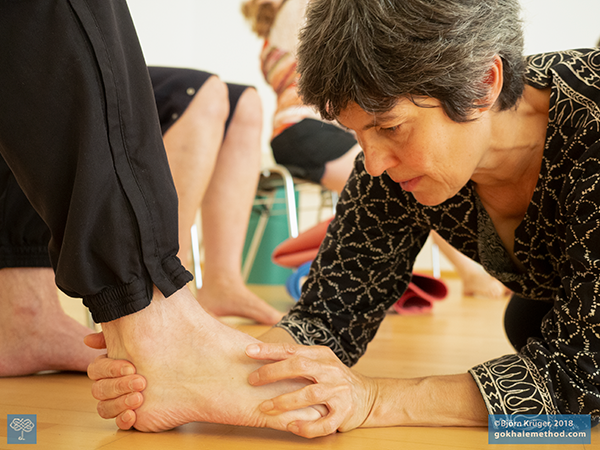Are Muscle Imbalances and Asymmetry Causing My Back Pain?
Many of the questions I hear from students are about concerns they have due to left/right asymmetry in their bodies. People will often see a clearly visible asymmetry as the root cause of any dysfunction and pain. This strikes me as a natural and understandable assumption—but my experience as a posture educator leads me to think there is more to consider here than meets the eye.

Anna Wintour of Vogue magazine sporting a symmetrical bob haircut. Wikimedia
Searching for symmetry
Visual symmetry is highly prized by our species; we have adapted, over millennia, to find symmetry attractive. Research¹ shows, for example, that we look for symmetry in our mates, and that is because symmetry in the body correlates with a lack of genetic defects, high function, youth, and good health. Human attraction is multilayered of course, and our species seeks out many other qualities such as intelligence, kindness, and even a sense of humor, but symmetry is known to be given a high value.
As a consequence of this adaptation, the human eye and brain are highly sensitized to picking up asymmetry. We use this ability in everyday tasks such as decorating cakes, or pruning in the garden—and in professions like art, hairstyling, and product design.

A formal garden imposes symmetry on Nature to great effect. Pixabay
When it comes to assessing the body, physical therapists and doctors often rely on being able to compare one side of the body with the other to determine what is healthy and normal for any individual patient. Asymmetry may be an early indication of injury, swelling, or even stroke—it can signal a condition that needs urgent medical attention.
Some asymmetry is usual, and a part of how we function
Throughout our history and prehistory, our species has used our body asymmetrically. By examining a stone tool, we can tell if the knapper was right-handed or left-handed. Similarly, spear-throwers in indigenous societies use one arm or the other, not both. And many modern athletic endeavors are strongly asymmetric in nature.
As the result of many hours of practice with a racket, bat, or club, many of today’s elite sportspeople become prodigiously one-sided. And yet it seems most don’t suffer any more from this asymmetry than the average person. Their preference for one side over the other will likely extend into a preferred rotational direction, weight-bearing arrangements, and an “anchor versus action” relationship between the left and right sides of the body. It seems we have the wherewithal to be asymmetric in both our structure and movements and still be highly functional.

Serena Williams in action. Many human activities demand very different
actions and specialization on each side of the body. Wikimedia
Asymmetry is not a diagnosis
In contemporary bodywork and ergonomic circles, we have gone too far with an insistence on symmetry. It's common for people to be told they have "muscle imbalances" and to believe this much touted diagnosis to be the root cause of their aches and pains. In fact, for most minor asymmetries, our bodies have very adequate compensations, structurally and positionally, and there is no urgent need to symmetrize. Clumsy or overly aggressive interventions to symmetrize an intricate system that has evolved over a lifetime can even do harm rather than good.
In particular, it is helpful to have an informed perspective about scoliosis, that is, lateral curvature of the spine. To be told you “have a scoliosis” can sound like a serious medical condition. Like many medical terms that sound like a diagnosis, it is essentially a description, using the ancient Greek skolios, or “bent.” We nearly all have some degree of lateral bend or rotation in our spines, most of which does not produce any symptoms as our bodies find organic adaptations and compensations.

This man’s torso shows muscle imbalances and a mild scoliosis. Imgur
When asymmetry is problematic
However, sometimes asymmetry is the problem. If your asymmetry is pronounced, or has an obvious correlation with symptoms, it may be at the root of your problem, or at least be a significant contributory factor. In this scenario it makes sense to work with a healthcare professional of your choice, such as a physical therapist, chiropractor or osteopath, orthopedic consultant, or other musculoskeletal specialist. For babies, children, and adolescents, who are still growing rapidly, interventions can, in general, be more conservative and highly effective.
For older children and adults, treatments for musculoskeletal issues will be much more likely to hold and bring long-term improvement when they are accompanied by postural reeducation. Several of our teachers have experience of working with their own imbalances, and actually became Gokhale Method teachers when they discovered that changing their posture was the “missing piece” in resolving their symptoms—you can read teacher Cynthia Rose’s story here.
Techniques that help the body to symmetrize
Lengthening shortened muscles is integral to most Gokhale Method techniques—using the rib anchor, growing the neck tall, stretchsitting, stretchlying on the back and on the side—all have a lengthening component that helps to ease out tight curves in the muscles and soft tissues. As the tightness releases to a more normal tone, “slack” underused parts of the body’s structure are called upon to engage and do their duty, restoring symmetry to both form and function.
Students often notice a newfound symmetry when they learn tallstanding. They discover a much more stable and athletic stance. Restacking the bones in a way that respects their skeletal architecture improves the relationship with gravity and has a symmetrizing effect. Progressing to hip-hinging, students combine a well-arranged lower body (kidney-bean shaped feet and externally rotated legs), with a well-integrated upper body (shoulders rolled back, neck tall, and engaged inner corset), leaving their pelvis free to rotate and nestle deeply between the thigh bones. This transforms bending from a high-risk activity into a highly functional one that no longer leaves SI joints and lower backs at the mercy of asymmetrical stresses. Many are amazed to find touching their toes not only possible, but pleasurable!

Julia shows how a restricted and uncomfortable left hip and SIJ area used to prevent healthy turnout on that side.
Daily participation in the Gokhale 1-2-3 Move has brought significantly greater symmetry, and freedom from pain.
One student’s experience
Julia Guenther joined the Gokhale 1-2-3 Move program last year and has been so delighted with her symmetrizing experience that she would like to share it with Positive Stance readers.
My asymmetry comes from the left SIJ (sacroiliac joint) and hip area. The left hip cannot turn out as much or as comfortably as the right hip. I noticed this when stretching, exercising, putting on shoes, etc. When I relaxed in a reclined position, my feet were not symmetrical from the vertical centerline. The left foot was more straight up and down and the right about 30 degrees from the centerline. My left side would get uncomfortable even in a reclined position.
I started the daily Gokhale 1-2-3 Move class in October. In January I had to go to the dentist for a chipped tooth and noticed that my elevated feet in the dentist’s chair looked symmetrical when I looked at them, and I was not uncomfortable like I used to be in the dentist’s chair. I have been stretching, doing yoga, and massaging the area for years, and after three months of Gokhale daily classes and reminders I have achieved relaxed symmetry. Although I could live the rest of my life happily with this amount of improvement, I now believe my left side hip and SIJ will someday become as mobile as my right hip and SIJ.
As happened for Julia, when people improve their postural form, some self-regulation occurs, and their bodies undergo degrees of symmetrization. Whether asymmetries are minor or major, this process can start immediately when Gokhale Method principles are applied: for example, a shoulder roll can enable a hiked-up shoulder to relax and reposition itself, or kidney-bean shaping a flat foot will straighten and support an inwardly rotated knee. Over time, the soft tissues and bony structures remodel to these new arrangements, bringing a more permanent symmetry to the body.

Esther teaches a student to kidney-bean shape a foot.
Calming the perfect storm
For the most part, our culture is caught up in a perfect storm: on the one hand we have a hyperawareness of musculoskeletal pain, and on the other, a “hyper-ignorance” of posture. They unite in a vortex of back pain, around 85% of which is diagnosed as “nonspecific,” i.e., cause unknown. The Gokhale Method hypothesis is that our culture’s ignorance as to the postural cause of most back pain connects to many misdiagnoses that asymmetry is the cause of our back problems.
It seems likely to me that a degree of asymmetry which could cause issues for the average modern person with problematic posture is less likely to do so in someone who enjoys healthy posture. So for most people I would say, consider relaxing around your small asymmetries, and instead invest in improving your posture in general. Consider joining us on the Gokhale 1-2-3 Move program, or immersing yourself in the Gokhale Method Foundations Course or Gokhale Elements. Regaining your healthy baseline posture, which is your birthright, can allow your structure to heal and harmonize. Pain-Free.
We would love to hear how these reflections on symmetry resonate for you…
¹Wade, T. Joel. “The Relationships between Symmetry and Attractiveness and Mating Relevant Decisions and Behavior: A Review,” Symmetry 2, no.2 (June 2010): 1081–1098. doi:10.3390/sym2021081

Comments
Dear Esther,Would you add any
Dear Esther,
Would you add any comments on this article?
https://philmaffetone.com/update-on-agin/
Great Post! What causes one
Great Post! What causes one leg to turn out farther than 30 degrees?
As a physical therapist, we
As a physical therapist, we often discuss "muscle imbalances" around a joint, too, and I have found that the Gokhale method is the best for activating the underused groups (arches of the foot, inner leg, abdominal corset/rib anchor, scapular stabilizers, and anterior cervical stabilizers) and thus reflexively "taming" the overused groups (lateral leg, quadratus lumborum, upper trapezius, pectoralis minor, sternocleidomastoid/scalene, etc) We encourage our clients to buy the book/take class and was happy to hear a new referral mention that the MD recommended Gokhale to her (having been introduced to it as our client)
Hi JaneIt would be helpful to
Hi Jane
It would be helpful to clarify- Which should one do first- strengthen the underused muscles before quietening the overused ones or vice versa?
I just sent one of my clients
I just sent one of my clients to your website for postural issues and she really benefitted from your work on pelvic tucking.
Thank you!
Add New Comment
Login to add commment
Login